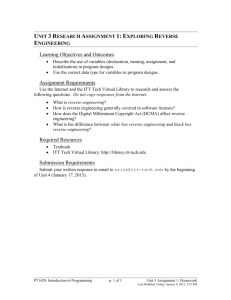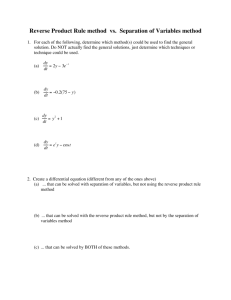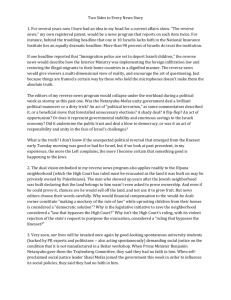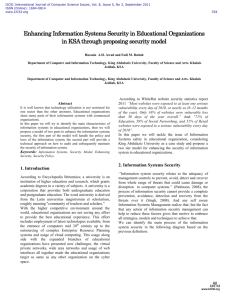Process of Reverse Engineering of Enterprise Information System
advertisement
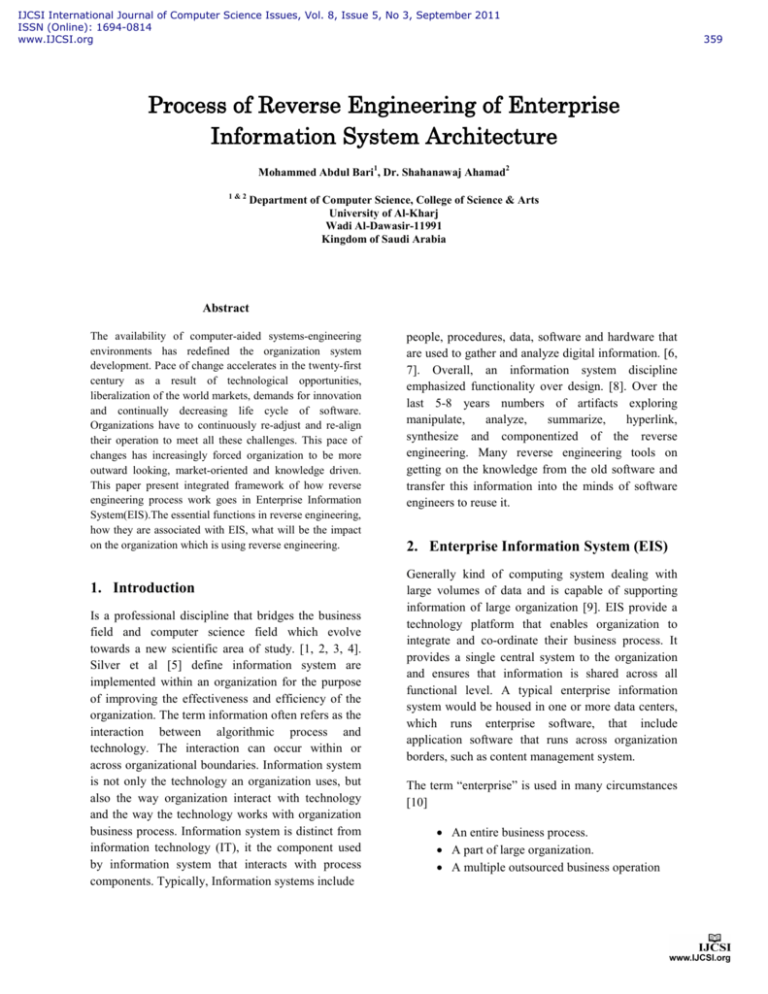
IJCSI International Journal of Computer Science Issues, Vol. 8, Issue 5, No 3, September 2011 ISSN (Online): 1694-0814 www.IJCSI.org Process of Reverse Engineering of Enterprise Information System Architecture Mohammed Abdul Bari1, Dr. Shahanawaj Ahamad2 1&2 Department of Computer Science, College of Science & Arts University of Al-Kharj Wadi Al-Dawasir-11991 Kingdom of Saudi Arabia Abstract The availability of computer-aided systems-engineering environments has redefined the organization system development. Pace of change accelerates in the twenty-first century as a result of technological opportunities, liberalization of the world markets, demands for innovation and continually decreasing life cycle of software. Organizations have to continuously re-adjust and re-align their operation to meet all these challenges. This pace of changes has increasingly forced organization to be more outward looking, market-oriented and knowledge driven. This paper present integrated framework of how reverse engineering process work goes in Enterprise Information System(EIS).The essential functions in reverse engineering, how they are associated with EIS, what will be the impact on the organization which is using reverse engineering. 1. Introduction Is a professional discipline that bridges the business field and computer science field which evolve towards a new scientific area of study. [1, 2, 3, 4]. Silver et al [5] define information system are implemented within an organization for the purpose of improving the effectiveness and efficiency of the organization. The term information often refers as the interaction between algorithmic process and technology. The interaction can occur within or across organizational boundaries. Information system is not only the technology an organization uses, but also the way organization interact with technology and the way the technology works with organization business process. Information system is distinct from information technology (IT), it the component used by information system that interacts with process components. Typically, Information systems include people, procedures, data, software and hardware that are used to gather and analyze digital information. [6, 7]. Overall, an information system discipline emphasized functionality over design. [8]. Over the last 5-8 years numbers of artifacts exploring manipulate, analyze, summarize, hyperlink, synthesize and componentized of the reverse engineering. Many reverse engineering tools on getting on the knowledge from the old software and transfer this information into the minds of software engineers to reuse it. 2. Enterprise Information System (EIS) Generally kind of computing system dealing with large volumes of data and is capable of supporting information of large organization [9]. EIS provide a technology platform that enables organization to integrate and co-ordinate their business process. It provides a single central system to the organization and ensures that information is shared across all functional level. A typical enterprise information system would be housed in one or more data centers, which runs enterprise software, that include application software that runs across organization borders, such as content management system. The term “enterprise” is used in many circumstances [10] • An entire business process. • A part of large organization. • A multiple outsourced business operation 359 IJCSI International Journal of Computer Science Issues, Vol. 8, Issue 5, No 3, September 2011 ISSN (Online): 1694-0814 www.IJCSI.org It also include the social-technical system [11] • • • • People. Information. Technology. Business. Domain 3: • 2.1 Enterprise Architecture (EA) Enterprise architecture uses various business method, analytical techniques and conceptual tools to understand the dynamics of an enterprise in doing so, they produce lists, drawing, documents models which together called artifacts [12]. The artifacts describe organization business functions, business capabilities, business process, information resource, software application, and information exchange and communication infrastructures within the enterprise. The collection of artifacts completes enterprise architecture [13].The enterprise has been shown in figure 1. The Enterprise Architecture is divided into 4 domains as shown in figure 1. Domain 1: • Business Architecture: • Business strategies are taken , goals are maps with the help of operation model [14,15] • Functional decompositions • Business process, workflow, rules that assign authorities [16]. • Organization cycle. Domain 2: • Application Architecture : • This domain mainly acts interface between applications taking like messages, events. Information Architecture : • Data architecture: It describes how the data is processed, how it is stored, how the project team used the data. • Master data management: It ensures that an organization does not use multiple versions of the same data in different parts of its operation, which is common in large organization. • Metadata: It describes enterprise data elements. Domain 4: • Technology Architecture : • It deals with application execution environments, operating framework which include application server environment ,operating system, authentication and its environment , security systems and other things, • Hardware platform, local and wide area network connection, internet connectivity diagram and programming languages. 3. Reverse Engineering It is a process of analyzing required system’s components, their interrelationships to create representation of the system in another form [17]. Reverse engineering often involves an existing system as its subject, where we can perform reverse engineering starting from any level or at any stage of the life cycle. It covers a broad range starting from the existing implementation, recreating the design, deciphering the requirement actually implemented by subject system. The figure 2 is shown, how reverse engineering process work in Enterprise. 360 IJCSI International Journal of Computer Science Issues, Vol. 8, Issue 5, No 3, September 2011 ISSN (Online): 1694-0814 www.IJCSI.org Domain -1 Domain -2 Domain -3 361 Domain -4 f Technical Technical Architecture Architecture Business Architecture Application Architecture Information Architecture SOS Data Architecture Computing Data network Infrastructure Telecom Sub domain of -1 Business Strategy Governance Even Architecture Analytic & Reporting Storage Transport Organization Application Portfolio Mata data & Semantics Middle ware Wireless Process Application Development Master data Management Database Voice Data quality Device Video Data integration Monitoring Project phase Business Architecture Application Architecture Fig 1: Enterprise Architecture [10] Information Architecture Infrastructure Architecture Telecom Architecture IJCSI International Journal of Computer Science Issues, Vol. 8, Issue 5, No 3, September 2011 ISSN (Online): 1694-0814 www.IJCSI.org 362 Domain 4 of EA Documentation After review the documentation the software is made. The software is made. New software Process the review design Review design High level of design information Domain 3 of EA Extract control flow information Domain 2 of EA Extract structures and functional information Domain 1 of EA Software information given to the top management Give permission for reverse engineering Top management, committed, Project management, Business strategies Fig 2: Reverse engineering process in Enterprise • Top management, business requirement, business strategies make the organization to go ahead with reverse engineering process, • which the organization is committed to their share holders and customers. All possible information about the software including source code, documentation for IJCSI International Journal of Computer Science Issues, Vol. 8, Issue 5, No 3, September 2011 ISSN (Online): 1694-0814 www.IJCSI.org the system cell, personnel experienced (required person) should be identify. This steps allows the software engineer(s) doing the recovery become familiar with the system and its components. This is also the domain -2 of the EA which explain the way the data will be processed. • Identifying the structure of the software and used to this to create a chart where each node represent function of the software, record the processing done by each node on a PDL [18] can be used to represent functionality routine, analyzed the PDL to identify data transformations in the software .Then identify the high –level control structure of the software which can be record by using control-flow diagram [19]. The high –level control will give an idea of overall operation for the software , which is nothing but the domain-3 of the EA ,where all inventories ,diagram, functions line are represented . • In review see all the information of the software is available, identify any missing functions, and review the design again. • After reviewing, the next step is to generate design documentation .Information explaining the business advantage of the software, software overview, its history and the complete software design steps. • The final step is to process the software, which is nothing but make the software based on the documentation provided to the software 363 engineer(s). These also include application execution environment, operating system, platform software and other things which is nothing but the domain - 4 of the EA. 4. Impact on organization Today especially large organizations are not only faced with the problem of replacing their information system with the new ones, but they have to maintain again. Reverse engineering provide the means for this purpose supporting in recapturing lost information, restructuring complex system to new one and more maintaining the architecture .The pressure from the market and from the stakeholder’s has let to extremely short product life cycle, most of the released software product never comes in the maintenance phase but instead of being maintained, they are replaced by the new one. For this, too much emphasis is been given on the early phases of the software life cycle, covering only the development part of the software. Large organization, particularly those in fast growing high-tech companies are looking for alternative strategies to minimize their risks and also product new software product, for this companies are seriously think of reverser engineering as the technology [20,21]. Reverse engineering not only increase the structure. It will break down the hierarchical structures, freeing the people to be more innovative and more flexible. Reverse engineering Abstract level Knowledge Information New software product Old software Transformation Fig 3: Reverse engineering used in organization IJCSI International Journal of Computer Science Issues, Vol. 8, Issue 5, No 3, September 2011 ISSN (Online): 1694-0814 www.IJCSI.org 5. Conclusion The field of IT support system has moved away from stand-alone, dedicated solution with localized impact to more integrated, flexible enterprise-wide system, a fresh approach was needed. In essence enterprise architecture bring with it. Not only it addresses organizational business change perspective but also support the software configuration. This paper has provided a frame work for examining reverse engineering process with the help of Enterprise architecture. Reverse engineering is rapidly becoming a recognized and important component of the future software environments. It provides a major link in the overall process of software development and maintenance. Reverse engineering, used with evolving software development will provide significant enhancement to new software product. The proposed architecture of reverse engineering (which has taken enterprise architecture in to account also) human expertise is used on well defined occasion to overcome statement situation because of hybrid nature and goal oriented approach. The most promising direction in this area is the continuous software understanding approach. The premise the software reverse engineering need to applied continuously throughout the lifetime of the software and it is important to understand the potential reconstruct the early design and the architectural decision. For the future it is critical that we can effectively answer questions such as “how much knowledge, what level of abstraction do we need to extract from the software, to make informed decision about reengineering”. It will be never able to predict all needs of the reverse engineering and their fore, must developed tools are the end user programmable. Software architecture is now established in many computer science course but the topics such as software evolution, reverse engineering and software migration are rare. References [1] Archibald, J.A. "Computer science education for majors of other disciplines". (May 1975). AFIPS Joint computer conferences: 903–906. [2]Denning, Peter, "Computer science the discipline”. Encyclopedia of Computer Science (2000 Edition). [3]Coy, Wolfgang. "Between the disciplines". (June 2004), ACM SIGCSE Bulletin 36 (2): 7–10. [4]Hoganson, Ken."Alternative curriculum models for integrating computer science and information ".(December 2001) Journal of Computing Sciences in Colleges 17 (2): 313–325. [5]Mark S. Silver, M. Lynne Markus, Cynthia Mathis Beath ,” The information technology interaction model: A foundation for the MBA core course”, (Sep,1995) MIS Quarterly, Vol. 19, No. 3 [6]Wikipedia ,” Information architecture “ ,(2010), http://en.wikipedia.org/wiki/Information_architecture [7]Wikipedia,” Information system”,(2010), http://en.wikipedia.org/wiki/Information_systems [8]Freeman, Peter; Hart, David, "A science of design for software-intensive systems computer science and engineering", (2004), Communications of the ACM 47 (8): 19–21 [9]Wikipedia, ”Enterprise information system”,(2010), http://en.wikipedia.org/wiki/Enterprise_Information_Sy stem [10]Wikipedia ,”Enterprise architecture,” (2010) http://en.wikipedia.org/wiki/Enterprise_architecture [11]Giachetti, R.E., “Design of enterprise systems, theory, architecture, and methods”, CRC Press, Boca Raton, FL, (2010). [12]Pelle Ehn ,”Work-oriented design of computer artifacts”. Erlbaum Associates Inc. Hillsdale, NJ, USA,(1990) [13]Spewak, Steven H. and Hill, Steven C. “Enterprise architecture planning - Developing a blueprint for data applications and technology”, John Wiley,(1992). 364 IJCSI International Journal of Computer Science Issues, Vol. 8, Issue 5, No 3, September 2011 ISSN (Online): 1694-0814 www.IJCSI.org [14]Richard Lynch, John Diezemann and James Dowling, “The capable company: Building the capabilities that make strategy work”, Wiley-Blackwell,(2003) 15]Bruce R. Scott, "Stages of corporate development (Part I)" ,Harvard Business School Note 371-294. 365 Dr. Shahanawaj Ahamad is an active academician and researcher in the field of Software Reverse Engineering with experience of ten years, working with Al-Kharj [16]Howard Smith and Peter Fingar,” Business process management”, The Third Wave, MK Press(2003). [17]Elliot J.Chikofsky ,James H.Cross N,” Reverse engineering and design recovery : A Taxonomy ,”,IEEE,(1990). University’s College of Science & Arts in Wadi Al-Dawasir, K.S.A. He is the member of various national and international academic and research groups, member of journal editorial board and reviewer. He [18]Stephen H.Caine ,E.Kent Gordon ,”PDL: a tool for software design”, AFIPS '75 Proceedings, (1975). is currently working on Legacy Systems Migration, Evolution and Reverse Engineering, published more than twenty [19]Ward.P.T,”The transformation schema :Data flow diagram to represent control and timing “,IEEE,(1986) papers in his credit in national and international journals and conference proceedings. He holds M. Tech. followed by Ph.D. in Computer Science major Software Engineering, [20]H.M.Sneed,,” Economics of software engineering “, journal of software maintenance , (Sep 1991) supervised many bachelor projects and master thesis, currently supervisor of Ph.D. theses. [21]H.M.Sneed and A.Kaposi,” A study on the effect of reengineering upon software maintainability”, IEEE Computer society press, (1990). [22]Hausi A.Muller, Jens H.Jahnke, Dennis B.Smith ,Margarat-Anne Storey , Scott R.Tilly,Kenny Wong,”Reverse engineering : A road map “, [23]Mohammed Abdul bari, Dr.Shahanawaj Ahmed,”Managing knowledge in development of agile software “,IJACSA,( 2011) About the Authors: Mr. Mohammed Abdul Bari is an Information System Architect and improvement. research expert in handling software process His area includes Business Process Reengineering, Process Modeling, Information System Redesign and Reengineering. He did B.E. in Computer Science & Engineering from Bangalore University, INDIA and M.S. in Information Systems from London South Bank University, United Kingdom, currently pursuing Ph.D. in Computer Science from University of Newcastle, District Columbia, U.S.A.

